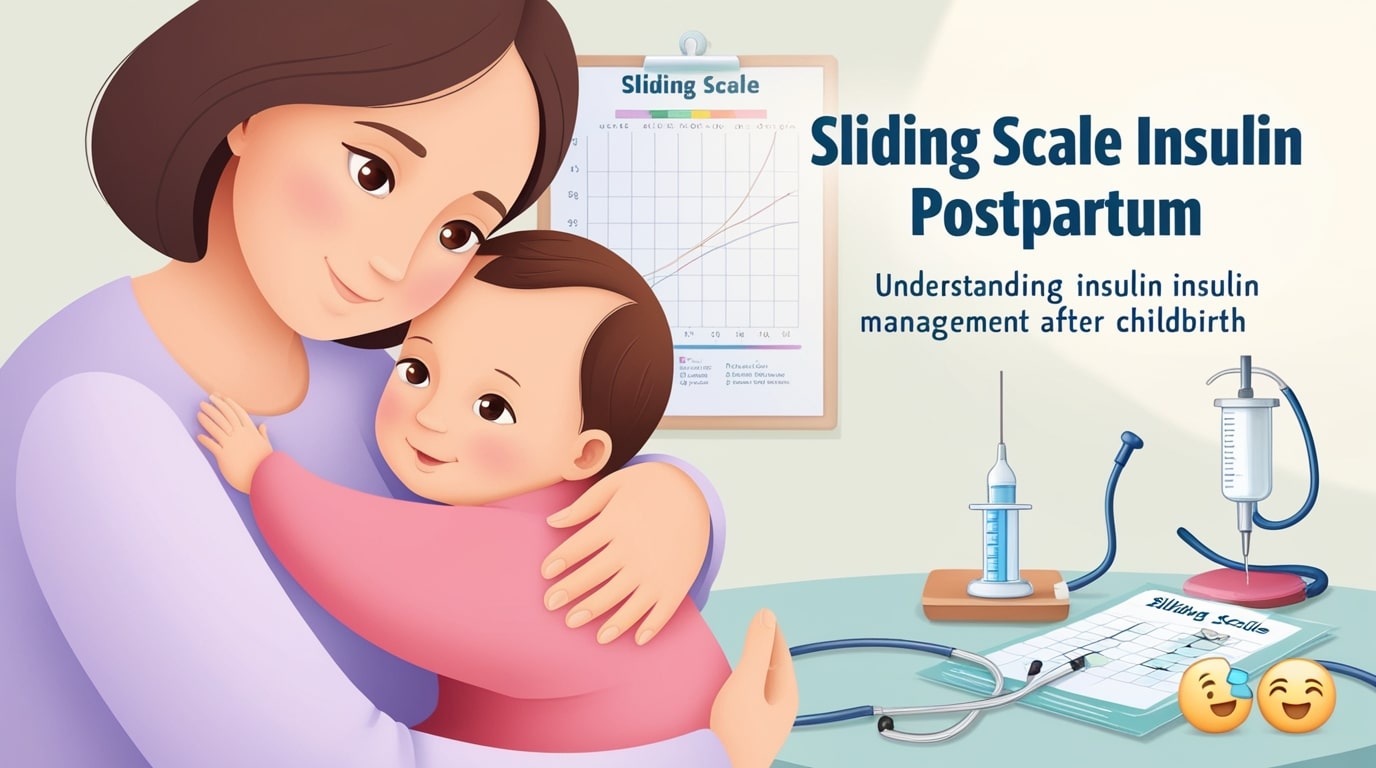Managing blood sugar levels after childbirth can be a crucial aspect of postpartum care, especially for women who had gestational diabetes or pre-existing diabetes. Sliding scale insulin is a common method used to adjust insulin doses based on blood sugar levels, and it plays a significant role in managing diabetes during the postpartum period.
In this article, we will explore what sliding scale insulin is, how it is used postpartum, and what new mothers need to know about managing their blood sugar after giving birth. Let’s break it down step-by-step to make it easy to understand. 😊
What Is Sliding Scale Insulin? 💉
Sliding scale insulin is a method used to adjust insulin doses based on current blood sugar levels. Instead of taking a fixed amount of insulin at set times, the dose is determined by how high or low your blood sugar is at any given time. This method helps keep blood sugar within a target range by providing flexibility in insulin management.

Key Features of Sliding Scale Insulin:
- Customizable: The insulin dose changes depending on blood sugar levels.
- Short-term management: Often used in hospitals or during acute conditions to stabilize blood sugar.
- Effective for postpartum: Helps manage fluctuating blood sugar levels after childbirth.
Key aspects of Sliding Scale Insulin Postpartum
| Aspect | Description |
|---|---|
| Purpose | Adjust insulin doses based on blood sugar levels to manage postpartum blood glucose fluctuations. |
| How It Works | Blood sugar is monitored at regular intervals, and insulin doses are adjusted accordingly using a sliding scale that specifies the insulin units needed per range. |
| Common Monitoring Times | Before meals, at bedtime, and sometimes after meals to ensure proper blood sugar control. |
| Postpartum Challenges Addressed | Blood sugar fluctuations, insulin sensitivity changes, and hormonal shifts after childbirth. |
| Benefits | Provides flexibility in insulin dosing, helps manage unpredictable postpartum blood sugar changes, and prevents complications like hyperglycemia or hypoglycemia. |
| Risks/Considerations | Requires frequent blood sugar monitoring, potential variability in insulin needs, and the need for ongoing medical consultation. |
| Use of B.R.A.I.N | Helps new mothers make informed decisions: understanding Benefits, Risks, Alternatives, Intuition (gut feeling), and doing Nothing (pausing to evaluate options). |
| Target Group | Women with gestational diabetes, type 1 diabetes, or type 2 diabetes managing blood sugar after giving birth. |
| Duration of Use | May be short-term for women with gestational diabetes; longer-term for those with pre-existing diabetes (depending on individual needs). |
Why Is Sliding Scale Insulin Used Postpartum? 👶
After childbirth, blood sugar levels can fluctuate significantly, especially for women who had gestational diabetes or pre-existing diabetes. During pregnancy, the body requires more insulin due to hormonal changes, but after delivery, insulin needs can drop quickly. Sliding scale insulin helps adjust insulin doses based on these fluctuations to prevent high or low blood sugar levels.
Common Postpartum Challenges:
- Decreasing Insulin Needs: Insulin resistance typically decreases after childbirth, meaning insulin doses may need to be adjusted downwards.
- Breastfeeding: Breastfeeding can also impact blood sugar levels, as it requires additional energy, potentially lowering blood sugar.
- Hormonal Shifts: The body’s hormonal changes can make blood sugar control more unpredictable during the postpartum period.
How Sliding Scale Insulin Works Postpartum ⚖️
When using sliding scale insulin postpartum, blood sugar levels are monitored frequently, often before meals and at bedtime. Based on the blood sugar reading, the dose of insulin is adjusted to bring the blood sugar back to the target range. This personalized approach ensures that insulin doses are matched to the body’s changing needs during the postpartum period.
| Blood Sugar Reading (mg/dL) | Insulin Dose (Units) |
|---|---|
| 70 – 150 | 0 units (no insulin) |
| 151 – 200 | 2 units |
| 201 – 250 | 4 units |
| 251 – 300 | 6 units |
| Above 300 | 8+ units (consult doctor) |
Note: This is a sample sliding scale; exact numbers will depend on a doctor’s recommendation.
Postpartum Blood Sugar Monitoring 🩺
Frequent blood sugar checks are essential when using a sliding scale insulin regimen postpartum. Monitoring helps determine how your body is responding to insulin and whether adjustments are needed. Some women may only need insulin for a short time after childbirth, while others (such as those with type 1 or type 2 diabetes) may continue insulin therapy long-term.
When to Monitor Blood Sugar:
- Before meals: Helps determine the right insulin dose before eating.
- At bedtime: Ensures stable blood sugar levels overnight.
- After meals: Sometimes recommended to check how your body responds to food.
Benefits of Sliding Scale Insulin Postpartum 💡
Using sliding scale insulin after giving birth offers several benefits to new mothers managing their blood sugar:
- Flexibility: Insulin doses are not fixed and can be adjusted based on daily blood sugar readings, offering more personalized care.
- Immediate Response: Allows for quick adjustments to insulin dosages if blood sugar levels suddenly rise or fall.
- Short-Term Use: For women with gestational diabetes, sliding scale insulin may only be necessary in the immediate postpartum period as blood sugar levels normalize.
- Prevention of Complications: Helps avoid complications such as hypoglycemia (low blood sugar) or hyperglycemia (high blood sugar) during the postpartum recovery phase.
Risks and Challenges of Sliding Scale Insulin ⚠️

While sliding scale insulin is helpful, there are some potential challenges to be aware of:
- Frequent Monitoring: Requires regular blood sugar testing, which can be time-consuming and stressful for new mothers.
- Variable Insulin Needs: Insulin needs can change rapidly, making it challenging to predict how much insulin will be required day-to-day.
- Short-Term Solution: Sliding scale insulin is generally a short-term approach and may not be suitable for long-term diabetes management.
FAQs: Sliding Scale Insulin Postpartum ❓
What is sliding scale insulin?
Sliding scale insulin is a method of adjusting insulin doses based on current blood sugar levels, providing flexibility in managing diabetes. It’s often used short-term, especially during times of rapid blood sugar changes, such as the postpartum period.
Why is sliding scale insulin used postpartum?
After childbirth, blood sugar levels fluctuate, particularly in women with gestational diabetes or diabetes. Sliding scale insulin helps adjust insulin doses based on blood sugar levels, preventing spikes or drops during recovery.
How often should I check my blood sugar postpartum?
When using sliding scale insulin postpartum, you should monitor blood sugar several times a day—usually before meals, at bedtime, and sometimes after meals—to ensure accurate insulin dosing.
Can I stop using insulin after giving birth?
For women with gestational diabetes, insulin may only be needed temporarily after childbirth. However, those with type 1 or type 2 diabetes will likely need to continue insulin therapy.
How does breastfeeding affect blood sugar levels?
Breastfeeding can lower blood sugar levels, so it’s important to monitor levels closely and adjust insulin as needed during breastfeeding.
What if my blood sugar stays high despite using sliding scale insulin?
If your blood sugar levels remain consistently high, you may need to consult your healthcare provider to adjust your insulin regimen or consider other treatment options.
Conclusion: Sliding Scale Insulin Postpartum 🏁
Sliding scale insulin offers a flexible and effective way to manage blood sugar levels after childbirth, especially for women with gestational diabetes or pre-existing diabetes. By adjusting insulin doses based on blood sugar readings, it helps new mothers keep their blood sugar in check during a time of significant hormonal and physical changes.
For best results, work closely with your healthcare provider to monitor your blood sugar levels, adjust insulin doses as needed, and ensure a smooth postpartum recovery. 😊

